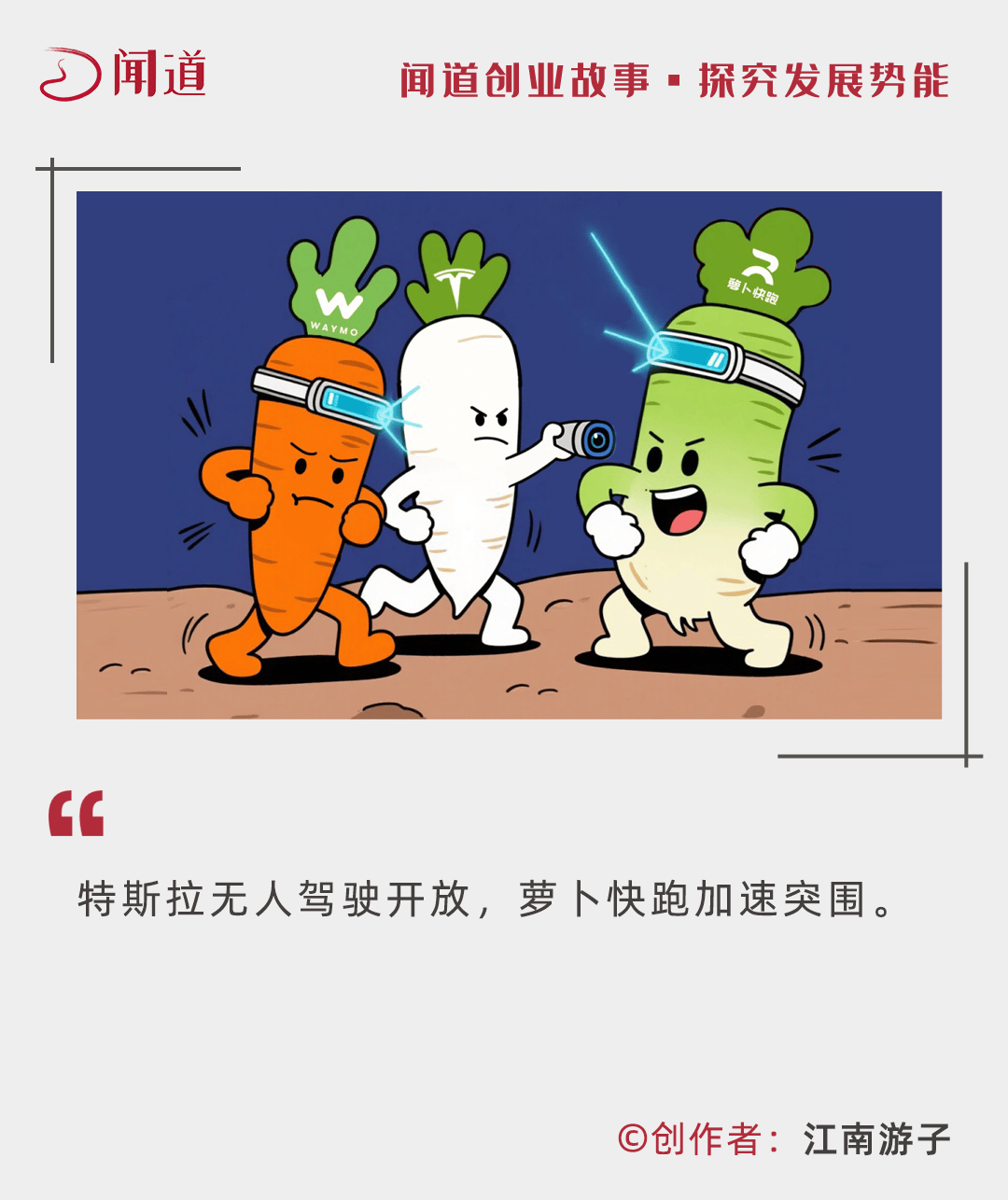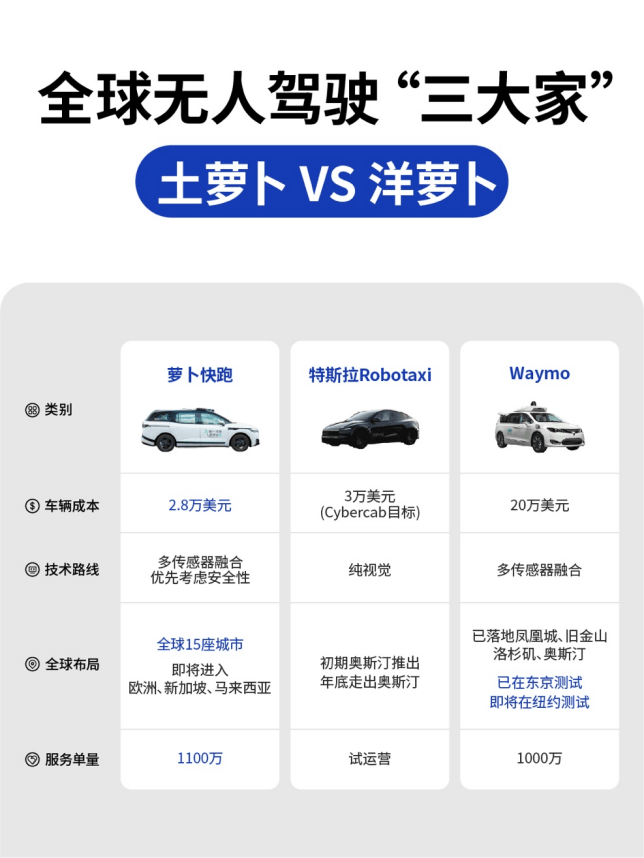Tesla's Robotaxi Launch Faces Challenges; Autonomous Driving Shines in the East Amidst Western Setbacks
![]() 06/30 2025
06/30 2025
![]() 615
615

After returning from White House politics to his role as CEO of Tesla, Musk's bet on autonomous driving appears to have hit another hurdle.
On June 22, local time, Tesla's long-awaited Robotaxi service finally launched in Austin, USA. However, the initial deployment of approximately 10 Robotaxis was not the globally anticipated cybercab but modified Model Y vehicles. Each test vehicle was equipped with a safety officer in the front passenger seat to ensure safety and handle emergencies.
Despite Musk's caution, opinions on Tesla's Robotaxi have been mixed since the start of the trial operation, with videos of frequent accidents during driving raising concerns about the maturity and safety of its pure vision technology.
For instance, there were instances of reverse driving and chaotic lane changes, including one test vehicle abruptly changing lanes into the opposite direction on a six-lane main road and continuing to drive in the wrong direction for 6 seconds, during which the steering system also experienced unexpected vibrations.
Additionally, there were cases of sudden braking and abnormal parking, with emergency braking in the absence of obstacles causing passengers' belongings to scatter. In some instances, vehicles even came to an abrupt stop at intersections, fortunately with the intervention of safety officers to terminate the drive.
Furthermore, issues with unclear road conditions and sign recognition arose, with one blogger reporting that after seeing a speed limit sign of 48 km/h, the vehicle's speed did not decrease but increased.
Just one day after its launch, Tesla's Robotaxi was investigated by the National Highway Traffic Safety Administration (NHTSA).
Musk had previously set an ambitious goal of having millions of Tesla vehicles with full self-driving capability on the world's roads by the end of 2026.
Despite the underwhelming trial operation of Tesla's Robotaxi, the situation in the East is more promising than in the West, with Chinese autonomous driving, represented by Luobo Kuaipao, heading towards the global market.
01 A Must-Win Battleground for the Trillion-Dollar Market
The Robotaxi market is emerging as a crucial battleground.
Nvidia CEO Jen-Hsun Huang stated that the next decade will be the era of autonomous vehicles (AVs), robots, and autonomous machines. Among these, autonomous driving integrates communication, semiconductors, automobiles, and other technologies, serving as a key convergence point between the automotive and technology industries.
A report by Goldman Sachs predicts that the global Robotaxi market will experience explosive growth, reaching a market size of $40 billion to $45.7 billion by 2030, with a compound annual growth rate (CAGR) of over 60%. This market is entering a phase of beta growth, with clear momentum towards the trillion-dollar market potential.
Moreover, the concept of Robotaxi extends beyond just a transportation tool; it is a mobile third space that can be flexibly transformed. Leisure, socializing, and business handling have already been realized in this space, suggesting that Robotaxi has the potential to become a new interaction channel, significantly impacting the reconstruction of urban business formats and transcending the limitations of traditional transportation tools.
Musk's rush to launch the modified Model Y before the cybercab could be mass-produced underscores the allure of Robotaxi from another perspective.
With the starting gun fired, in addition to Tesla, Luobo Kuaipao and Waymo have also demonstrated remarkable performance.

As a leading global autonomous driving enterprise, Luobo Kuaipao has expanded its footprint worldwide.
According to data, Luobo Kuaipao has been launched in 15 cities globally, including Beijing, Shanghai, Wuhan, Chongqing, Hong Kong, Dubai, Abu Dhabi, and is exploring entry into Switzerland and Turkey, with plans to establish a physical company in Switzerland as a strategic outpost for its autonomous driving business to expand into Europe. As of May this year, Luobo Kuaipao has completed 11 million service orders, surpassing Google's Waymo's 10 million orders.
Google's Waymo is not far behind. In terms of the number of cities launched, Waymo currently operates in four cities in the US and has applied for a permit from the New York City Department of Transportation, aiming to push for changes to New York State laws to enable the deployment of its fully autonomous vehicles. In overseas markets, Waymo has already conducted autonomous driving tests in Tokyo, Japan.
The competition among the "Big Three" of autonomous driving, represented by Luobo Kuaipao, Google's Waymo, and Tesla, is intensifying.

Currently, Luobo Kuaipao is clearly ahead, with its vehicle costs compressed to an extreme of $28,000. Waymo's disadvantage lies in its high costs, but its advantages include a more relaxed regulatory environment, a natural foundation for the global market, and the deployment of more vehicles, with a current fleet size of over 1,500 vehicles. This makes Waymo's potential for explosive growth feasible. Once external conditions are met, Waymo has a good chance of overtaking.
From multiple perspectives, this competition is a "duet" between Luobo Kuaipao and Waymo, and Tesla currently lacks the basic conditions to compete at the same level. However, Musk's influence, his widespread market appeal globally, and the past experiences of Tesla and SpaceX indicate that Musk's companies tend to grow exponentially rather than linearly. Even if only 1% of the ambitious goal of deploying over 100,000 vehicles in a year is achieved, it could quickly catch up with Waymo. Therefore, Tesla remains a force that cannot be ignored.
Currently, in the "Big Three" landscape of Robotaxi, there are fewer Chinese enterprises than American ones, and the situation of "two foreign radishes" versus one is unfavorable for the development of autonomous driving in China. Disharmonious voices and excessive criticism in the public opinion field are becoming "shackles" hindering the further development of China's autonomous driving industry.
02 Removing Shackles
As a typical application scenario of large vision models in the physical world, autonomous driving vehicles integrate communication, semiconductors, automobiles, and other technologies, and have become a crucial battleground for cross-border competition and cooperation between the automotive and technology industries of various countries.
For China, this is a competition that must be vigorously defended.
The autonomous driving market is a blue ocean, and Robotaxi is currently the most clearly monetizable path in this vast market. Without Luobo Kuaipao, Waymo and Tesla would also compete for the Chinese market, and in the era of autonomous driving, the "third space" would be divided up, which is obviously not conducive to the development of China's autonomous driving technology.
Considering the practices of Waymo and Tesla, it is evident that regulatory policies and legislation are crucial for the development of autonomous driving.
As early as 2017, Texas passed special legislation allowing companies to test driverless vehicles on public roads without additional approvals or the need for a driver. This prompted Waymo and Tesla to shift their testing focus to Austin, which subsequently became an important testbed for Robotaxi.
In Europe, relevant countries are also "untying the knots" for autonomous driving. The UK has published the Autonomous and Electric Vehicles Act, laying the legal foundation for autonomous vehicles to legally hit the roads by 2026. In Germany, relevant legislation was passed in 2021 allowing L4-level autonomous vehicles to legally operate on specific roads, making it one of the first countries in the world to establish a national regulatory framework. France, the Netherlands, and other countries are also continuously optimizing their policy environments to provide a more relaxed and flexible development soil for autonomous driving enterprises.
This demonstrates that policy is a prerequisite for the significant development of Robotaxi at the current stage. In other words, the fiercely competitive Chinese market is urgently calling for further deregulation of supervision.
Zhu Xichan, a professor at Tongji University's School of Automotive Studies and director of the Institute of Automotive Safety Technology, mentioned that China and the United States have always been the most influential players at the global autonomous driving table. If China wants to seize the initiative in future competitions in artificial intelligence, especially in autonomous driving, relevant departments need to provide enterprises with an open and inclusive policy environment and accelerate legislation on autonomous driving, allowing local autonomous driving enterprises to truly take off under the principle of "equal rights for humans and vehicles."
Any technology will encounter numerous challenges during its growth stage, but one should not stop eating for fear of choking. Autonomous driving represents the future direction of development, a surging trend, and such a window of opportunity will not always exist. Currently, the situation of foreign "radishes" encircling Luobo Kuaipao has emerged in the autonomous driving field, indicating that the number of Chinese enterprises is far from sufficient. There is an urgent need to create better policy and regulatory conditions and a harmonious public opinion environment to help more enterprises stand out, go global, and win in the competition.







